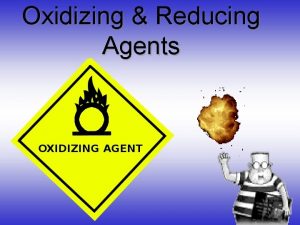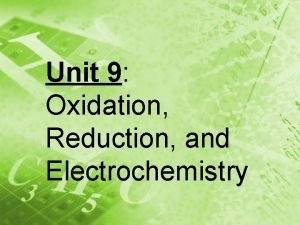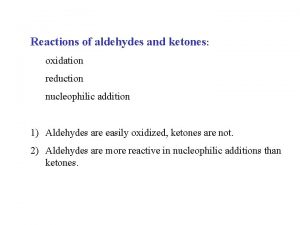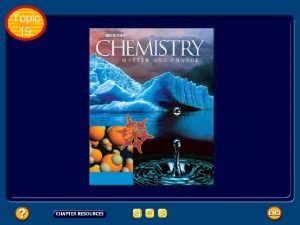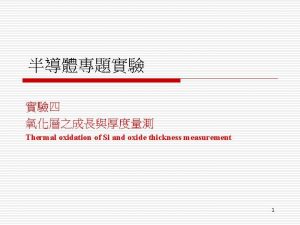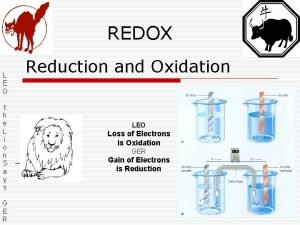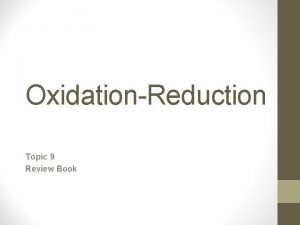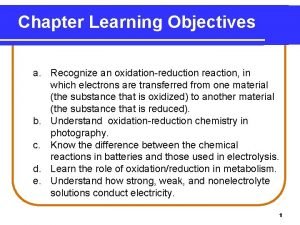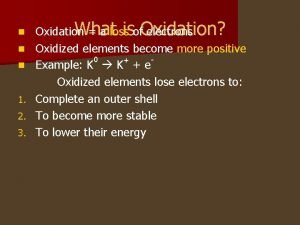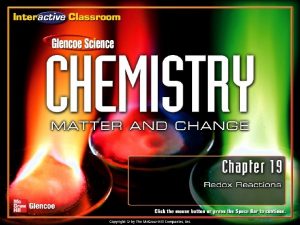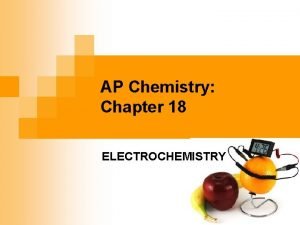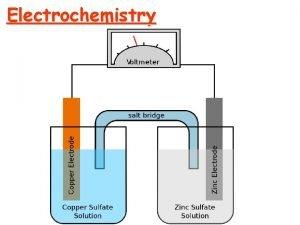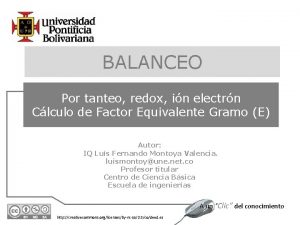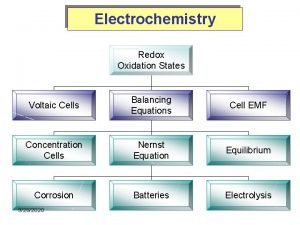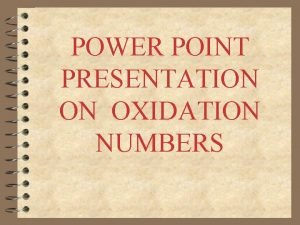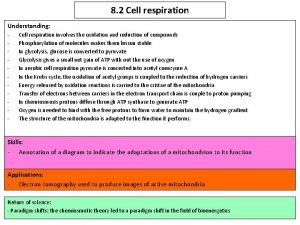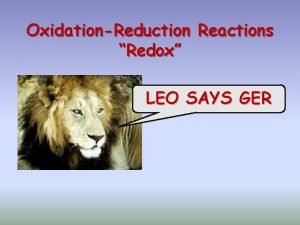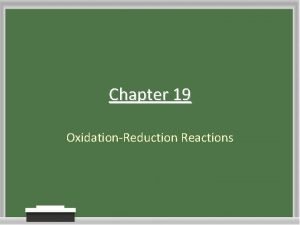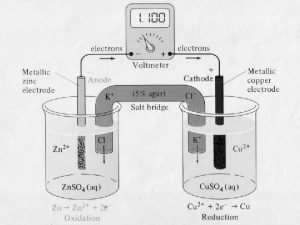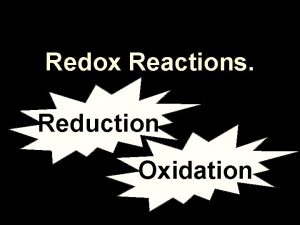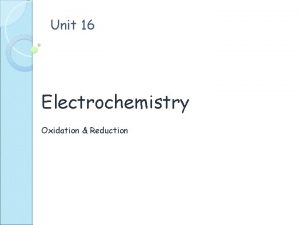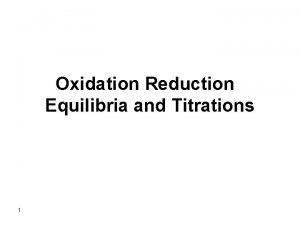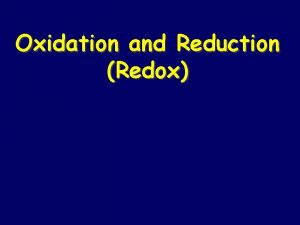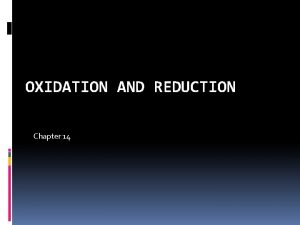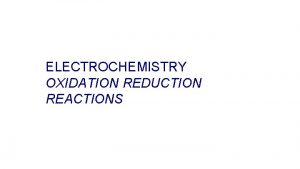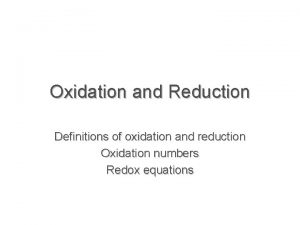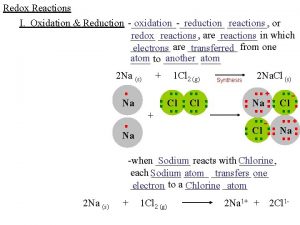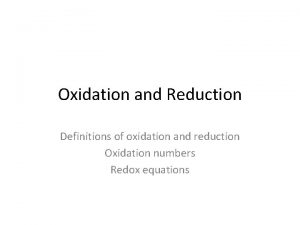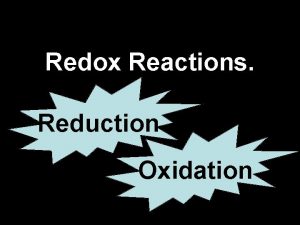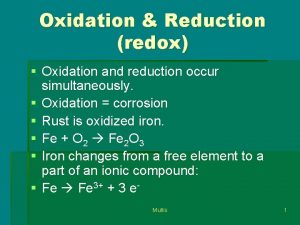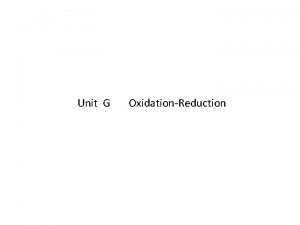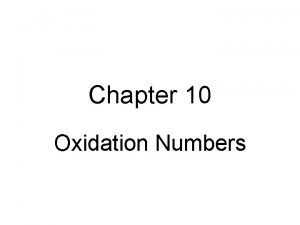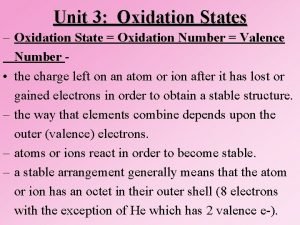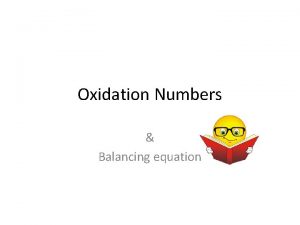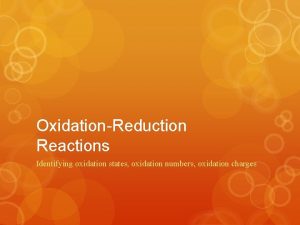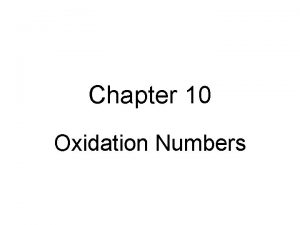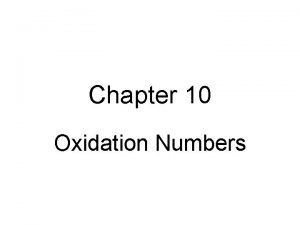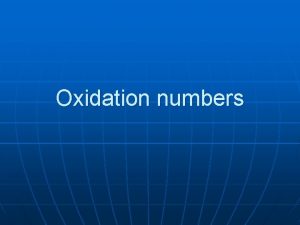Respiration Respiration Respiration is an oxidation reduction reaction
























- Slides: 24

Respiration • • Respiration: Respiration is an oxidation reduction reaction in which organic foods are oxidized to CO 2, and O 2 absorbed in this process is reduced to form water • . Redox process E = 2870 k. J/mol, 685 kcal/mol (1 cal = 4. 19 J) • • Oxidation: Addition of O 2 or Removal of electrons or Removal of protons (hydrogen) • • Reduction: Removal of O 2 or Addition of electrons or Addition of protons (hydrogen) • • Heat energy + ATP (Metabolic energy)

Respiration • Respiratory substrates • These are the compounds that completely breakdown to give rise carbon dioxide and water as a • result of this, energy is released. • • Respiratory intermediates • • These are the compounds which are completely broken down to give rise CO 2 and H 2 O. • • In addition to respiratory substrates, some other compounds are produced during the • breakdown of respiratory substrates which are known as respiratory intermediates. • • Glucose CO 2 + H 2 O • • All compounds produced as a result of 50 reactions are known as intermediates.

Respiratiion • • Types of respiratory substrates • • Following are the four different types of respiratory substrates • 1. Carbohydrates • 2. Lipids or Fats • 3. Organic acids • 4. Proteins • • These are all organic compounds and are utilized in respiratory phenomenon • • Carbohydrates: Monosaccharide, Disaccharides, Oligosaccharides, Polysaccharides • • i) Monosaccharide: Trioses, Tetroses, Pentoses, Hexoses • • ii) Disaccharides: Two units of monosaccharide are attached e. g. • • Maltose = Glucose + Glucose • • Sucrose = Glucose + Fructose

Respiration • Trisaccharides e. g Raffinose suger=Galactose , glactose and fructose • Tetrasaccharide e. g. Stachyose sugar = Gal + G + F • • Pentasaccharides e. g. Verbascose sugar = Gal + G + F • • Hexasaccharides e. g. Ajugose sugar = Gal + G + F • • iii) Oligosaccharides: Dextrins - almost ten glucose molecules • • Inulin - polymer of fructose (30 -40 fructose units) • • iv) Polysaccharides: Starch: It is a storage carbohydrate in plants and consists of • two types of subunits • • a) Amylose α-1, 4 -linkage • • b) Amylopectin α-1, 6 -linkage

Respiration • 2. Lipids or Fats: Generally in plants fat is present in low amount and its distribution is large and its • occurrence is maximum in oil-seed crops. Fat is converted into glycerol and fatty acids by the action of • lipase enzyme and then both glycerol and fatty acids give rise to sucrose and other sugars in the process • generally known as gluconeogenesis (when glucose or sugars are formed from organic substances other • than sugars). • 3. Organic acids: • 1. Malate (CAM plants) • 2. Glycolate • 3. Citrate • 4. Proteins: • • If these are stored and sugar is not available then proteins are converted into sugars.

Respiration • The Respiratory Quotient: • • If carbohydrates such as sucrose, fructose or starch are respiratory substrates and if they are • completely oxidized, the volume of O 2 taken up exactly balances the volume of CO 2 released • from the cell. This ratio of CO 2/O 2 called respiration quotient or RQ. • • RQ obtained from leaves of many different species averaged about 1. 05. Germinating seeds of • cereal grains and many legumes such as peas and beans, which contain starch as main reserve • food, also show the value of RQ approximately 1. 0. Seeds from many other species, however • contain much fat or oil. RQ value for these species is often as low as 0. 7. Consider the oxidation • of common fatty acid, oleic acid • • C 18 H 34 + 25 O 2 18 CO 2 + 17 H 2 O • • RQ for this reaction is 18/25. 5 = 0. 71 • • By measuring RQ for any plant part, information can be obtained about the type of compound

• Breakdown of Starch • • It is a polymer of glucose and is a main storage product in plants. In cereals, the amount of • starch varies from 65 -75%. In mature potato 80% starch is present. • • Breakdown enzymes of starch are of four types • 1. α-amylase • 2. β-amylase • 3. Phosphorylase • 4. De-branching enzyme • 5. α-amylase: • 6. By the action of α-amylase a mixture of linear and branched chains is obtained such as glucose • , • fructose, maltose and in case of amylopectin dextrins are formed.

• 7. β-amylase: • 8. β-amylase produces maltose from the starch. It removes maltose unit from long chain of starch. • 9. Phosphorylase: • 10. It gives rise glucose-1 -phosphate when the level of inorganic phosphate is high (greater than • 1 m. M). • 11. De-branching enzymes: • 12. These enzymes attack on 1, 6 -linkages of amylopectins • 13. Isoamylase • 14. Pullulanase • 15. Breakdown of Sucrose: • 16. Two enzymes are involved in the breakdown of sucrose. • 17. Sucrose synthase: • 18. Sucrose synthase is present in cytosole • 19. Reaction is reversible • 20. Invertase: • 21. Sucrose Glucose + Fructose

• 21. Sucrose Glucose + Fructose • 22. Invertases are present in three forms • 23. Acidic invertase: Present in cell wall and vacuole (apoplast) • 24. Alkaline invertase: Present in cytosol • 25. Neutral invertase: Mostly present in apoplast • 26. The cell wall invertase hydrolyses incoming sucrose into glucose and fructose that are then absorbed by sink cells.

• Mechanism of Respiration • Respiration is of two types • 1. Aerobic respiration i. e. in the presence of O 2 • 2. Anaerobic respiration i. e. in the absence of O 2 • 1. Aerobic respiration: Aerobic respiration can be divided into four major steps • i) Glycolysis = Hexose 2 trioses [Pyruvate (PA) • ii) Oxidative decarboxylation = PA Acetyl Co. A • iii) Krebs cycle = Acetyl Co. A CO 2 • iv) Electron transport chain/system

• 2. Anaerobic respiration: Anaerobic respiration can be divided into two steps • i) Glycolysis • ii) Fermentation • Various conditions on the basis of O 2 availability • i) Hypoxic condition: Low amount of O 2 • ii) Anoxic condition: Zero oxygen • • Soil is porous, O 2 of atmosphere can move through these pores or gases form a phase around • soil particles. When water logging occurs, diffusion of O 2 decreased so plants observe hypoxic • condition. Anaerobiosis (anaerobic condition) may be due to water logging or some other • factors e. g. pressed soil also has no O 2 so condition is anaerobiosis.

History of glycolysis • History • The pathway of glycolysis as it is known today took almost 100 years to fully discover. • The combined results of many smaller experiments were required in order to understand the pathway as a whole. • The first steps in understanding glycolysis began in the nineteenth century with the wine industry. For economic • reasons, the French wine industry sought to investigate why wine sometimes turned distasteful, instead of fermenting into alcohol. • French scientist Louis Pasteur researched this issue during the 1850 s, and the results of his experiments began the • long road to elucidating the pathway of glycolysis. • His experiments showed that fermentation occurs by the action of living microorganisms; and that yeast's glucose • consumption decreased under aerobic conditions of fermentation, in comparison to anaerobic conditions.

• In a series of experiments (1905 -1911), scientists Arthur Harden and William Young discovered more pieces of glycolysis. • They discovered the regulatory effects of ATP on glucose consumption during alcohol fermentation. They also shed light on the role of one compound as a glycolysis intermediate: fructose 1, 6 -bisphosphate. • The elucidation of fructose 1, 6 -bisphosphate was accomplished by measuring CO 2 levels when yeast juice was incubated with glucose • . CO 2 production increased rapidly then slowed down. Harden and Young noted that this process would restart if an inorganic phosphate (Pi) • was added to the mixture. Harden and Young deduced that this process produced organic phosphate esters, and further experiments allowed • them to extract fructose diphosphate (F-1, 6 -DP).

• Arthur Harden and William Young along with Nick Sheppard determined, in a second experiment, that a heat-sensitive high-molecularweight subcellular fraction (the enzymes) and a heat-insensitive low-molecular-weight cytoplasm fraction (ADP, ATP and NAD+ and other cofactors) are required together for fermentation to proceed. • This experiment begun by observing that dialyzed (purified) yeast juice could not ferment or even create a sugar phosphate. • This mixture was rescued with the addition of undialyzed yeast extract that had been boiled • . Boiling the yeast extract renders all proteins inactive. . The ability of boiled extract plus dialyzed juice to complete • fermentation suggests that the cofactors were non-protein in character.

• With all of these pieces available by the 1930 s, Gustav Embden proposed a detailed, step-by-step outline of that pathway we now know as glycolysis. • The biggest difficulties in determining the intricacies of the pathway were due to the very short lifetime and low steadystate concentrations of the intermediates of the fast glycolytic reactions. • By the 1940 s, Meyerhof, Embden and many other biochemists had finally completed the puzzle of glycolysis. • The understanding of the isolated pathway has been expanded in the subsequent decades, to include further details of its • regulation and integration with other metabolic pathways.

• Glycolysis • Embden - Meyerhof and Parnass (EMP pathway) • Hexose bisphosphate pathway • • Glycos = Sweet or sugar and lysis = breakdown • • Glycolysis is lysis or breakdown of sugars • • Glycolysis occurs in all types of organisms in prokaryotes and eukaryotes and it can take place in • the presence as well as in the absence of O 2. • In animals glycolysis starts from glycogen which is a • reserve carbohydrate in liver and muscles whereas in plants since the major reserve or storage • carbohydrate is sucrose, so first of all breakdown of sucrose takes place and later on hexoses • which are resulted from this breakdown are utilized in glycolysis. • In animals and plants glycolysis • takes place in cytosol but in plants glycolysis also occurs in chloroplast. Only one reaction of • glycolysis in plants also takes place in vacuole i. e. conversion of phosphoenol pyruvate in the • presence of enzyme phosphatase which is present in vacuole.



• The first five steps of Glycolysis are regarded as the preparatory (or investment) phase. • , since they consume energy to convert the glucose into two three-carbon sugar phosphates.



• • In Plants: • • In plants net balance is 6 ATPs when the route is through ATP-PFK. When PPi-PFK is operative at • 1 st step of glycolysis then there will be saving of energy equivalent to 1 ATP, so net balance of • metabolic energy in glycolysis will be equal to 7 ATPs. • • In animals: • • In animals the situation is different. In animals NADH is either equal to 2 ATP or 3 ATP, • so depending upon the utilization of NADH in ETC in animals energy balance of glycolysis will be • either 6 ATP or 8 ATP.

Enzymes used in Glucolysis • Hexokinase • Phosphoglucose isomerase • Phosphofructokinase • Aldolase • Triosephosphate isomerase • Glyceraldehyde 3 phosphate dehydrogenase

• Phosphoglycerate kinase • Phosphoglycerate mutase • Enolase • Pyruvate kinase
 What are oxidising agents
What are oxidising agents Redox reaction
Redox reaction Basic permanent wrap
Basic permanent wrap Difference between oxidation number and charge
Difference between oxidation number and charge Oxidation of ketones
Oxidation of ketones Which equation represents an oxidation-reduction reaction
Which equation represents an oxidation-reduction reaction Dry oxidation vs wet oxidation
Dry oxidation vs wet oxidation What are redox reactions examples
What are redox reactions examples Oil rig leo ger
Oil rig leo ger Topic 9 oxidation-reduction
Topic 9 oxidation-reduction Oxidation–reduction reactions
Oxidation–reduction reactions Redox reaction chart
Redox reaction chart How to know oxidation and reduction
How to know oxidation and reduction Oxidation reduction reactions
Oxidation reduction reactions Oxidation reduction memory tricks
Oxidation reduction memory tricks What is e in nernst equation
What is e in nernst equation 2kclo3 2kcl 3o2 oxidation and reduction
2kclo3 2kcl 3o2 oxidation and reduction Redox leo ger
Redox leo ger Chapter 19 review oxidation-reduction reactions answers
Chapter 19 review oxidation-reduction reactions answers Concentration cell definition
Concentration cell definition What is an oxidation reaction
What is an oxidation reaction Oxidation reduction
Oxidation reduction Leo the lion says ger
Leo the lion says ger How to write reduction half reactions
How to write reduction half reactions Galvanic cells
Galvanic cells
